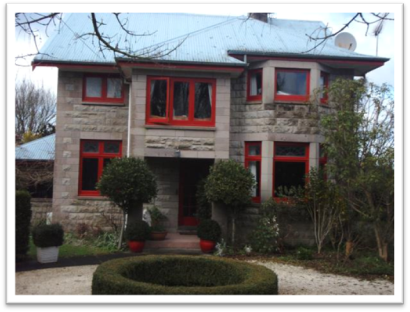HH-12: Stone House and Stone Outbuildings

Date of Photograph: 07/08/2008
Location and Zoning Information | |
Address |
56 Arapuni St, Putāruru |
Current Owner |
S Thom & B Baldwin |
Legal Description |
Pt Sec 15 Blk X Patetere Nth SD |
Zoning |
General Residential Zone |
Valuation Number |
0541715500 |
Google Maps Link |
|
Architecture | |
Date of Construction |
1930s |
Materials |
Ngutuwera Stone from Guillard's Quarry Lichfield. Two storey house. Floor plan similar on both levels. Garages and outbuildings of stone also. (HNZPT). |
Architecture/Engineer/Builder |
Unknown |
Condition |
Good |
Original Site Recommendation |
HNZPT Ref: 4279. Heritage Advisor, HNZPT. |
Current Use |
Private residence |
Statement of Significance |
(1 Historical) - aspect of history, associated with Mr PL Guillard, Guillard's stone quarry near Lichfield. Mr Guillard operated a quarry and obtained several government contracts for supply of stone for use in state buildings and private houses. (4 Commemorative) - was associated with events, persons or ideas of importance in South Waikato history. (10 Architectural) is an important example of construction using particular material, example of construction of a two storey house, garage, outbuildings using a particular material, locally quarried volcanic tuff from the homeowners quarry 'Guillard's Quarry' near Lichfield. (13 Integrity) has a good level of integrity, structure has not been modified. District Plan RulesDemolition -DIS. Protection focus - 1 and 10. Mitigate the effects of demolition by requiring the applicant to provide Historical Building Documentation (HBD) which should include: the structure history, photographic documentation and measurements of the item prior to removal. Alterations necessary for the primary purpose of improving structural performance, fire safety or physical access – CON -Refer to HH-R2. Other Additions/Alterations - DIS. Protection focus - 10 and 13. Effects can be mitigated/remedied through; a) HBD - See mitigating the effects of demolition. b) Design Rules: 1. The overall visual character/shape of the original building should be identifiable. The addition should not dominate the existing building. 2. New work should be to the rear of the building and not be evident from the road frontage. 3. The following special elements that are associated with the rarity or architectural uniqueness or craftsmanship of the structure should be retained: Elements of the structure that should be retained are those elements such as façade, exterior walls, openings, chimney, landscape and any other elements identified in the Historic Building Documentation. c) Building Materials Rule: If repair of the building is proposed the materials used for the exterior walls should be similar in type, dimensions and profile as the existing exterior fabric of the building. Repair of the Structure - PER. Refer to HH-R1 Protection focus - 10, 13 and stone. DIS - Stone. If repair of the buildings is proposed the materials used for the exterior walls should be similar in type, dimensions and profile as the existing exterior fabric of the building. Re-use/Change of Use -PER. Refer to HH-R1 Protection focus - 1. Internal Changes - DIS. Relocation - DIS. Protection focus - 1 and 10. Disturbance of the site surface/earthworks - Note: Any place that was associated with human activity prior to 1900 and is able to provide evidence relating to the history of New Zealand is an 'archaeological site' (refer to definition of 'archaeological site' in Section 2 of the Heritage New Zealand Pouhere Taonga Act 2014). All archaeological sites are protected under the Heritage New Zealand Pouhere Taonga Act 2014 and approval from Heritage New Zealand must be obtained prior to destroying, damaging or modifying any site. Accordingly, where this site on which a building is located is an 'archaeological site' and the building is to be repaired, added to, relocated or demolished and this involves disturbance to the surface and/or subsurface of the site, approval from Heritage New Zealand is required. |
History |
Built in the 1930s with Ngutuwera Stone from Guillard's quarry for Mr PL Guillard. (NZHPT). The stone is believed by many to be the best building material in the country and has been subjected to many severe tests, including being boiled in sulphuric and hydrochloric acid for three hours, immersed in sulphuric acid at 240 degrees Fahrenheit for four weeks, heated for fifteen minutes and plunged into cold water. The stone showed no signs of deterioration. (Te Waotu Arapuni Heritage Trail brochure). |
Additional Photographs

